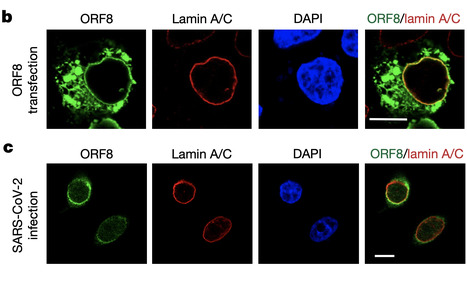Severe acute respiratory syndrome coronavirus 2 (SARS-CoV-2) emerged at the end of 2019 and caused the devastating global pandemic of coronavirus disease 2019 (COVID-19), in part because of its ability to effectively suppress host cell responses1–3. In rare cases, viral proteins dampen antiviral responses by mimicking critical regions of human histone proteins4–8, particularly those containing post-translational modifications required for transcriptional regulation9–11. Recent work has demonstrated that SARS-CoV-2 markedly disrupts host cell epigenetic regulation12–14. However, how SARS-CoV-2 controls the host cell epigenome and whether it uses histone mimicry to do so remain unclear. Here we show that the SARS-CoV-2 protein encoded by ORF8 (ORF8) functions as a histone mimic of the ARKS motifs in histone H3 to disrupt host cell epigenetic regulation.
ORF8 is associated with chromatin, disrupts regulation of critical histone post-translational modifications and promotes chromatin compaction. Deletion of either the ORF8 gene or the histone mimic site attenuates the ability of SARS-CoV-2 to disrupt host cell chromatin, affects the transcriptional response to infection and attenuates viral genome copy number. These findings demonstrate a new function of ORF8 and a mechanism through which SARS-CoV-2 disrupts host cell epigenetic regulation. Further, this work provides a molecular basis for the finding that SARS-CoV-2 lacking ORF8 is associated with decreased severity of COVID-19. The SARS-CoV-2 protein ORF8 functions as a mimic of histone H3 to disrupt host cell epigenetic regulation.
Published in Nature (Oct. 5, 2022):



 Your new post is loading...
Your new post is loading...







